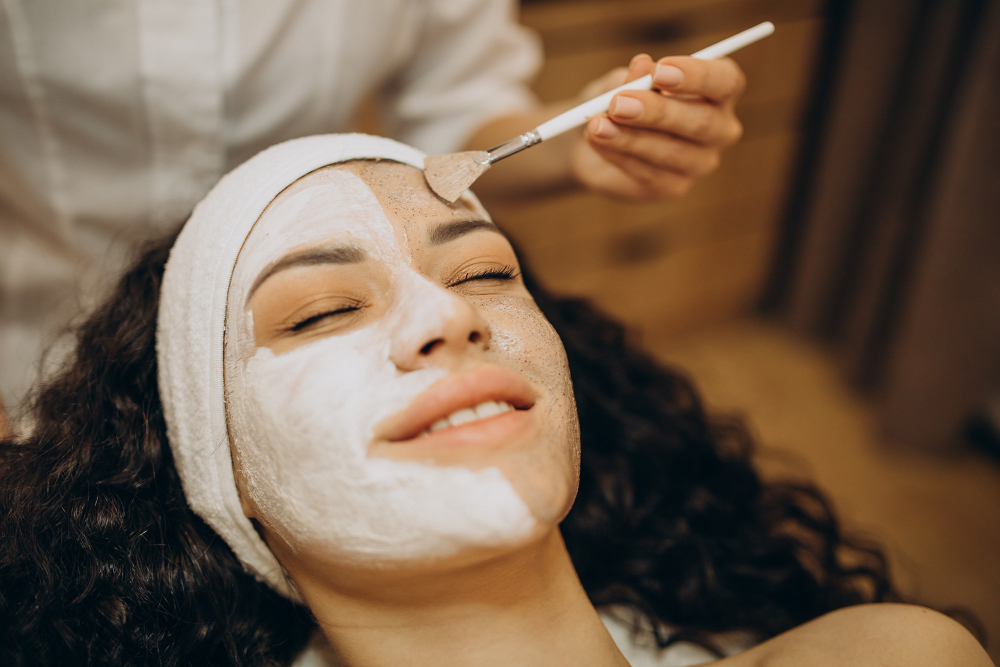/IN THIS ARTICLE
◊PART A
♥ The Ultimate Guide to Professional Exfoliation
♥ Microdermabrasion: Gentle Yet Effective
♥ Chemical peels: Out with the old and on with the new.
♥ Laser Resurfacing: Zapping Away Imperfections
♥ Finding the Right Treatment for You
♥ Wrapping It Up
◊PART B
♥ The Ultimate Guide to Exfoliation: How to Achieve Glowing, Healthy Skin
♥ What Exactly Is Exfoliation?
♥ Types of Exfoliation: Physical vs. Chemical
♥ How to Exfoliate Properly
♥ What Should You Use?
♥ Pro Tips for Effective Exfoliation
♥ Final Thoughts: Glow Smart, Not Hard
♥ FAQ
The Ultimate Guide to Professional Exfoliation: When You Need That Extra Boost – So, you’ve tried every scrub, peel, and mask below the sun, and your pores and skin still aren’t pretty where you need them to be? Sometimes, your skin wishes that greater push—a bit something greater than what your standard home exfoliation can provide. Enter professional exfoliation. If you’re yearning for extra dramatic outcomes, it is probably time to keep in mind the professional path. Dermatologists and skilled aestheticians have a slew of alternatives that could deeply refresh your skin, supplying effects that home remedies clearly can’t suit. But what precisely are these alternatives, and what can they do for you? Let’s dive in.
Microdermabrasion: Gentle Yet Effective
Ever wondered what it’d experience to have a tiny vacuum flow throughout your face? Well, that’s essentially what microdermabrasion is—a dermatologist makes use of a handheld device to deeply exfoliate the skin on your face and neck. It’s not as intense as it sounds, even though. In truth, it’s one of the gentler expert exfoliation strategies out there. Think of it as a supercharged facial scrub.
While the system is especially moderate, you would possibly revel in a sensation similar to a moderate sunburn in a while. Nothing too loopy, but something to be aware of in case you’re making plans to move out later on. And here’s the kicker: you may need to undergo a couple of periods to in reality see those sizeable modifications you’re after. But for lots, the payoff is really worth it—brighter, greater even pores and skin with a reduction in dark spots. It’s like pressing the refresh button for your face.
Chemical peels: Out with the old and on with the new.
If microdermabrasion is like a scrub on steroids, then chemical peels are the big guns of the exfoliation world. This treatment includes applying a chemical way to your skin, which then works its magic by casting off several layers of lifeless pores and skin. The end result? A brisker, more younger look that could help decrease the look of satisfactory strains, wrinkles, and discoloration.
Chemical peels come in various levels of intensity. You’ve got your moderate peels, which would possibly leave you with a bit of redness and flaking for some days, and you they’ve got your extra extreme versions. These horrific boys can take up to three weeks to fully heal however can deliver a few severely remarkable outcomes. If you’re seeking to genuinely rejuvenate your skin and address the pesky signs of growing older, a chemical peel could be just what the medical doctor ordered.
Related Article: How to exfoliate skin at home
Laser Resurfacing: Zapping Away Imperfections
When you believe you studied lasers, you might imagine something out of a sci-fi film, however, in the international of skincare, lasers are a high-tech way to zap away imperfections. Laser resurfacing remedies, which consist of options like extreme pulsed light (IPL), fractional lasers, and CO2 lasers, are designed to goal pores and skin issues which include discoloration, scars, and solar harm.
Here’s how it works: the laser removes the pinnacle layers of your skin, even as additionally stimulating collagen production in the deeper layers. This dual action no longer best addresses floor-level worries but additionally facilitates cleaning out your pores and skin from the inner out. It’s like getting an emblem-new skin without the want for a complete-on alternative.
However, it’s not all sunshine and rainbows—some redness and peeling are par for the route after a laser remedy. And just like with microdermabrasion and chemical peels, a couple of periods are probably needed to reap high-quality results. But for those searching to noticeably up their skincare game, laser resurfacing is a powerful device within the arsenal.
Finding the Right Treatment for You
So, how do you decide which expert exfoliation technique is proper for you? It all relies upon your pores and skin kind, your worries, and what kind of downtime you’re willing to tolerate. If you’re searching for a short pick-out-me-up with minimal healing, microdermabrasion might be your first-rate wager. On the opposite hand, in case you’re geared up for a more extreme treatment with longer-lasting outcomes, a chemical peel or laser resurfacing could be worth considering.
Before diving in, it’s critical to visit a professional who can check your pores and skin and recommend the maximum appropriate remedy. Professional exfoliation isn’t a one-size-suits-all answer, and having professional guidance could make all the difference in attaining the glowing, younger pores and skin you’re after.
Wrapping It Up
Professional exfoliation may be a game-changer on your skin, imparting consequences that go far beyond what you may achieve at home. Whether you opt for microdermabrasion, chemical peels, or laser resurfacing, the key is to discover the right remedy that fits your pores and skin’s needs. So, if your skin is crying out for a piece of greater TLC, why not deliver professional exfoliation a strive? Your pores and skin—and your destiny self—will thank you.
The Ultimate Guide to Exfoliation: How to Achieve Glowing, Healthy Skin
Exfoliation—it’s one of these skincare steps that can make all the distinction between stupid, worn-out-searching pores and skin and that radiant glow all of us crave. But right here’s the aspect: Not all exfoliation is created identical. Done right, it could screen clean, younger pores and skin. Done wrong, it is able to depart your face indignant and unhappy. So, permit’s dive into the nitty-gritty of exfoliating the proper way!
What Exactly Is Exfoliation?
In simple terms, exfoliation is the system of getting rid of useless skin cells from the floor of your skin. Our skin certainly sheds these cells, but every so often, they stick around longer than they need to—mainly due to clogged pores, rough texture, or even breakouts. That’s where exfoliation comes in to hurry up the procedure and keep your skin easy and clean.
Why Exfoliate?
- Boosts mobile turnover, revealing brisker, more youthful-looking skin.
- Helps unclog pores and save you acne.
- Improves absorption of serums and moisturizers.
- Creates a clean base for makeup utility.
- Brightens your complexion by way of eliminating stupid, useless skin cells.
Types of Exfoliation: Physical vs. Chemical
There are two foremost methods to exfoliate: bodily exfoliation and chemical exfoliation. Each has its execs and cons, so allow’s break it down.
Physical Exfoliation: The Scrubby Stuff
This technique uses a physical agent to manually eliminate useless skin cells. Think sugar scrubs, brushes, or exfoliating gloves.
Best for: The frame, but may be used on the face with a warning.
Examples:
- Sugar or salt scrubs
- Exfoliating brushes or gloves
- Microfiber washcloths
How to Use:
- Be mild—harsh scrubbing can lead to microtears and inflammation.
- Use circular motions to buff away lifeless pores and skin.
- Avoid bodily exfoliation when you have sensitive or acne-susceptible pores and skin, as it may cause infection.
Chemical Exfoliation: The Science-Backed Glow-Up
Instead of scrubbing, chemical exfoliants use acids to dissolve lifeless pores and skin cells, revealing fresh pores and skin below. These are tremendous for tackling choppy skin tone, acne, and dullness.
Two Main Types:
- AHAs (Alpha Hydroxy Acids): Water-soluble acids that exfoliate the pores and skin’s surface. Great for dry or solar-damaged skin.
- Glycolic Acid: Helps with uneven tone and texture.
- Lactic Acid: Gentle and hydrating, excellent for touchy pores and skin.
- BHAs (Beta Hydroxy Acids): Oil-soluble acids that cross deep into pores to unclog them. Perfect for shiny and acne-prone skin.
- Salicylic Acid: Helps with pimples, blackheads, and oil control.
How to Use:
- Start gradually—use 2-three instances a week and grow if wished.
- Apply after cleansing, however before serums and moisturizers.
- Avoid using AHAs and BHAs on the same day as retinol to save you irritation.
How to Exfoliate Properly
Exfoliation isn’t a one-size-suits-all situation. The frequency and approach rely on your pores and skin kind and the goods you operate.
How Often Should You Exfoliate?
- Oily & Acne-Prone Skin: three-four times a week (preferably chemical exfoliation)
- Dry & Sensitive Skin: 1-2 times a week (move for gentle alternatives like lactic acid)
- Normal & Combination Skin: 2-3 instances every week (a mix of physical and chemical exfoliation works well)
The Right Way to Exfoliate:
- Cleanse First: Start with a mild cleanser to take away dirt and makeup.
- Apply Exfoliant: For bodily exfoliants, use light, circular motions. For chemical exfoliants, practice a skinny layer and allow it to soak up.
- Moisturize: Always keep up with a hydrating moisturizer to protect your skin barrier.
- SPF is Non-Negotiable: Exfoliation makes your pores and skin extra touchy to the sun, so constantly follow sunscreen at some stage in the day.
What Should You Use?
Choosing the right exfoliant depends on your pores and skin’s desires. Here are some top choices:
- For Oily & Acne-Prone Skin: Salicylic acid (BHA) to unclog pores and reduce breakouts.
- For Dry & Sensitive Skin: Lactic acid (AHA) for gentle exfoliation and hydration.
- For Uneven Skin Tone: Glycolic acid (AHA) to decorate and smooth pores and skin texture.
- For Body Exfoliation: Sugar scrubs or dry brushing to dispose of difficult patches.
Pro Tips for Effective Exfoliation
- Always Patch Test: New exfoliants can be potent—take a look at them on a small area first.
- Avoid Over-Exfoliating: Too a whole lot can damage your pores and skin barrier, main to redness and sensitivity.
- Listen to Your Skin: If it feels indignant, take a smash!
- Pair with Hydration: Use a hydrating serum or moisturizer to refill your pores and skin after exfoliation.
- Consult a Dermatologist: If you have worries like rosacea or eczema, speak to an expert before exfoliating.
Final Thoughts: Glow Smart, Not Hard
Exfoliation is a skincare sport-changer, however, it’s all approximately stability. Overdoing it can do more harm than exact, whilst the proper technique can remodel your pores and skin. Whether you go for a scrubby session or a chemical peel, constantly pay attention to your pores and skin, live steady, and don’t forget about that SPF!
So cross beforehand—glow up responsibly!
More Tips: Refer – The NIVEA Guide
FAQ:-
1. What is expert exfoliation, and how does it differ from at-domestic exfoliation?
- Professional exfoliation involves deeper, greater managed treatments carried out by a licensed esthetician or dermatologist with the use of superior gear and products.
- At-home exfoliation generally uses gentler merchandise and techniques, offering an extra floor-level exfoliation, perfect for ordinary protection but much less amazing.
2. How frequently need to I timetable expert exfoliation sessions for the most desirable skin health?
- Every 4-6 weeks for maximum skin types, but your esthetician may also propose a customized agenda based totally on your pores and skin’s wishes.
- Sensitive skin kinds may want much less common sessions, whilst pimples-inclined or growing old pores and skin may also gain from more normal remedies.
3. Can expert exfoliation help with acne, scars, or different pores and skin imperfections?
- Yes, chemical peels and microdermabrasion can help reduce zits, and zits scars, and enhance ordinary skin texture.
- These treatments sell cell turnover, helping to vanish imperfections through the years.



Leave a Reply